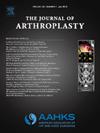Comparison of the Long-Term Clinical Results of Resurfacing Hip Arthroplasty for Japanese Patients Who Have Osteonecrosis versus Those Who Have Other Diagnoses
IF 3.8
2区 医学
Q1 ORTHOPEDICS
引用次数: 0
Abstract
Background
This study investigated the long-term (mean 13.5 years) clinical results of resurfacing hip arthroplasty (RHA) in Japanese patients who had osteonecrosis (ON) and compared the results with those of patients who had other diagnoses.
Methods
A consecutive series of 65 hips (50 men and 15 women), with 30 in the ON group and 35 hips in the nonosteonecrosis (non-ON) group, were included. The mean follow-up period was 13.5 years (range, 10 to 20). The Japanese Orthopaedic Association hip-scoring system was used to clinically evaluate hip function. In radiological assessment, the stem-shaft angle and inclination of the acetabular component were evaluated. Adverse reactions around the RHA were evaluated with Magnetic Resonance Imaging. Data on postoperative complications were retrieved from the medical records. Kaplan‒Meier analysis was used to compare the survival rate between the two groups.
Results
Significant improvement was observed between the preoperative and final follow-up Japanese Orthopaedic Association hip scores in both groups. Radiological assessments revealed no major changes in either group. There were none of the hips that required revision for adverse reactions. Femoral neck fractures were observed in three cases (ON group, n = 2; non-ON group, n = 1) and aseptic loosening of the femoral or acetabular component in two cases (ON group, n = 1; non-ON group, n = 1). Additional operations were performed for three hips in the ON group and two in the non-ON group. The 15-year survival rate was 90 and 94% in the ON and non-ON groups, respectively (P = 0.53). In the ON group, the 15-year survival rate was 92% in Type C1 and 90% in Type C2 cases (P = 0.84).
Conclusions
This study showed satisfactory mean 13.5 years clinical results of RHA in Japanese patients who had ON.
日本骨坏死患者与其他诊断患者行髋关节置换术的长期临床结果比较
背景:本研究调查了日本骨坏死患者行髋关节置换术(RHA)的长期(平均13.5年)临床结果,并将结果与其他诊断的患者进行了比较。方法:连续纳入65例髋关节(男性50例,女性15例),其中骨坏死组(ON) 30例,非骨坏死组(non-ON) 35例。平均随访时间为13.5年(10 ~ 20年)。采用日本骨科协会(JOA)髋关节评分系统临床评价髋关节功能。在放射学评估中,评估髋臼组件的干轴角和倾角。用磁共振成像(MRI)评估RHA周围的不良反应。术后并发症的数据从医疗记录中检索。采用Kaplan-Meier分析比较两组患者的生存率。结果:两组患者术前和最终随访JOA髋关节评分均有显著改善。放射学评估显示两组均无重大变化。没有一例髋部需要因不良反应而进行翻修。股骨颈骨折3例(ON组,n = 2;非ON组,n = 1),无菌性股骨或髋臼假体松动2例(ON组,n = 1;non-ON组,n = 1)。ON组的3个髋关节和非ON组的2个髋关节进行了额外的手术。ON组和非ON组15年生存率分别为90%和94% (P = 0.53)。ON组C1型15年生存率为92%,C2型为90% (P = 0.84)。结论:本研究显示日本骨坏死患者平均13.5年的RHA临床效果令人满意。
本文章由计算机程序翻译,如有差异,请以英文原文为准。
求助全文
约1分钟内获得全文
求助全文
来源期刊

Journal of Arthroplasty
医学-整形外科
CiteScore
7.00
自引率
20.00%
发文量
734
审稿时长
48 days
期刊介绍:
The Journal of Arthroplasty brings together the clinical and scientific foundations for joint replacement. This peer-reviewed journal publishes original research and manuscripts of the highest quality from all areas relating to joint replacement or the treatment of its complications, including those dealing with clinical series and experience, prosthetic design, biomechanics, biomaterials, metallurgy, biologic response to arthroplasty materials in vivo and in vitro.
 求助内容:
求助内容: 应助结果提醒方式:
应助结果提醒方式:


